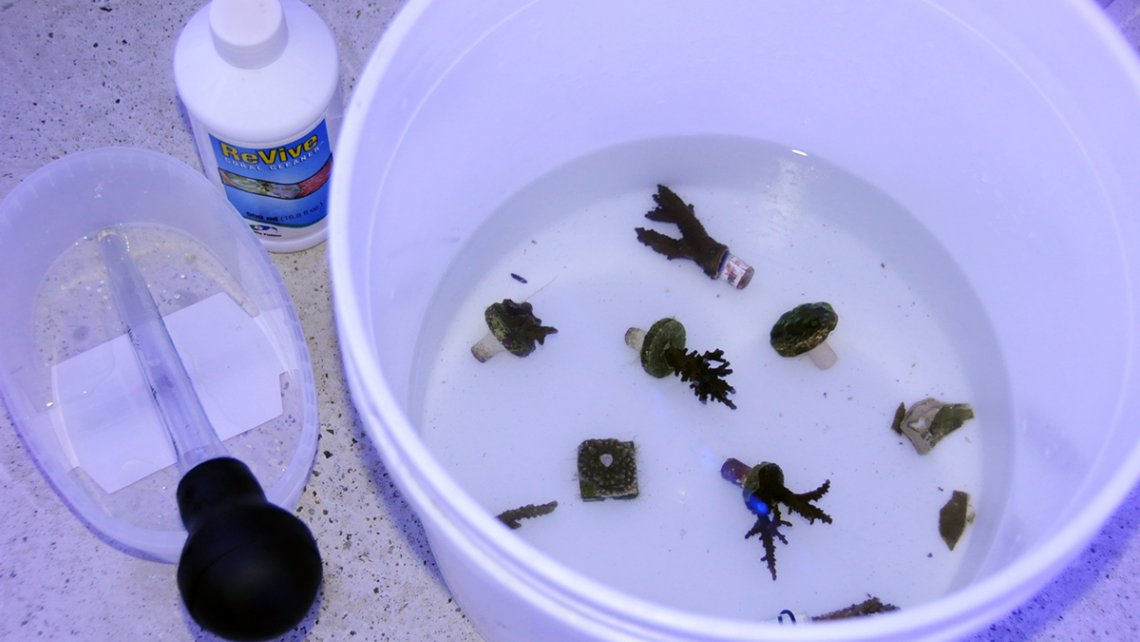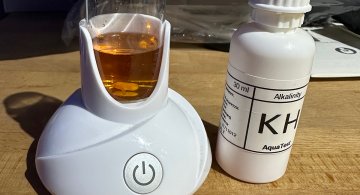Quarantine & Dips
You just got that new {insert item here}, is it safe to put it in your tank?
The short answer is no. No matter what new thing you purchase, it may have something on or in it that could become a real problem in your reef. Whenever you acquire a new coral, fish, or invertebrate, the most wise move you can make is to NOT put it in your reef. For someone new to the hobby, this seems like a huge hassle, but to any one of us that have been in the hobby for a while, we know that the risk is simply too great. Why does the seasoned reef keeper know this? Ha! Because we've learned the hard way that anything impulsive usually is folly, and results in hours, weeks, or months of heartache.
Let's focus on corals for the bulk of this article, since that is what tends to bring in the majority of pests. Whether you purchased a coral, or got a frag in trade, it absolutely must be put in quarantine. Over the years, I've encountered a number of hitchhiker pests as new livestock was acquired, and I've read countless discussion threads filled with frustration when those pests were discovered in their reef's corals. Specifically, there is quite a list of bad guys we would do best to avoid:
- Flatworms - Red Planaria
- Evil crabs - Blue eyed & black tipped claws
- Acropora-eating Flatworms (AEFW)
- Montipora-eating Nudibranchs
- Red Bugs
- Zoanthid-eating Spiders
- Zoanthid-eating Nudibranchs
- Star Polyp-eating Nudibranchs
- Manjano Anemonia and/or Aiptasia anemone
- Asterina Starfish
- Clam and Snail devouring flatworms
- Mollusc-eating flatworms
- Vermetid Worms
- Pyramidellid Snails
- Whelks
- Sundial Snails
- Parasitc Isopods
- and more...
That's quite a list, right? Yet each one of those, or a combination thereof, could sneak their way into a reef tank if the owner isn't carefully considering the best course of action to stop them. I've mentioned occasionally how I decline some opportunities because "I don't want to put any disease in my tank." If you aren't being cautious, you are risking your livestock or worse. Far better would be to have a plan of action in place, prior to getting more livestock.
For several years, I've been a big proponent of quarantining all new arrivals. It isn't hard if you have the tank set up and running at all times. Mine is a simple cube with some live rock. It is topped off daily or every other day to maintain salinity, and I have a few snails in the tank to keep it clean. The light it receives (indirectly) is from my
main reef's metal halides. Each time I siphon out water & waste accumulation, it is replaced with saltwater from my reef. I use it primarily for all new coral arrivals, since I get corals often and fish rarely. Even if my reef has some pests currently, I don't want to add more, that is for sure!

Above, a refugium lightbulb is used to light the tank. It will suffice for brief quarantine periods.
Whenever I get a new coral, the bag of water it came in floats for 20 minutes, then the coral is removed and placed in the tank on the rockwork for me to observe it. That same day, I dose the tank with a small amount of Interceptor to kill any red bugs. 12 hours later (or the next day), the coral is ready to be dipped for other possible pests. Because my quarantine tank is stable, there's no hurry to move the coral to my reef, which allows me to study the coral closely and see if there are any visual pests emerging. Also, if the frag has just been clipped from its parent colony that day, I avoid handling it as much as possible. I prefer to let it have a couple of days to heal up before I dip it and glue it to something.
It is believed that Interceptor only lasts about 24 hours once put in suspension, so even after the quarantine tank has been treated with a dose for a new arrival, I don't change the water. I've not seen any issues arise from this method, and as far as I'm concerned, the tank continues to be ready to accept any new corals. I probably change the water in the quarantine tank every couple of months when it needs a good cleaning. The rest of the time it just runs in stand-by mode.
When I'm ready to move the frag (now Red Bug free) to my reef, it is then put in a bowl of tank water with ReVive for five minutes (no more than ten minutes, ever). During the five minutes, I squirt it several times with a turkey baster from every possible angle to blast off any bugs, pods, nudibranchs or flatworms. It is then transferred to a new bowl of tank water to rinse for a few minutes. If you wish, it could next be placed in a bowl of tank water with a couple of drops of Iodine or Tropic Marine Pro Coral Cure (TPMCC) for a few minutes, again using the turkey baster method to flush out any bad guys. Just don't leave it in any dip solution for too long, especially if you are dipping multiple frags. As you work on one frag, the others are still stewing in the dip solution which often is determinental to the health of the coral. This is why I recommend putting the dipped frag in a bowl of tank water, as it gives you more time to work. If the frag needs to be mounted to a small rock, it can now be glued or puttied securely, and then is ready to be placed in your reef.

Tools: bowl, timer, ReVive, tukey baster. Blast the coral several times at differing angles during the dip.
I'm sure some of you wonder about that laundry list of bad guys listed above. Many of them are easy to spot if you take a few minutes and dip new corals:
Zoanthids tend to harbor all kinds of bad guys, and with a careful dip procedure, you can flush out nudibranchs, spiders, Sundial snails, and smaller starfish. Any of these can be removed with tweezers. If you suddenly see any of these in your main tank, use tweezers or forceps to pluck them out of your tank, watching for more on a daily basis until every last one has been extracted. If you see a small cluster of eggs on the side of a zoanthid polyp, scrape those away immediately before nudibranchs hatch into the system. People used to spread flatworms (Red Planaria) from system to system during their frag trading, but for the
most part this nuisance plague was squashed with Salifert's Flatworm eXit treatments.
Montipora sp. can be plagued with montipora-eating nudibranchs.
These are pretty tough to spot, and the coral should be inspected very closely for any. A dip in Potassium permanganate can kill them, but has also been known to kill the coral. Garlic extract may do the job adequately. If you receive a coral with an infestation, it might be best to just toss it rather than take the risk of introducing any nudis into your beautiful tank, as they will devour and devastate healthy corals if given the opportunity. You can often find them on the underside of a plating Montiopora sp. because that is where the eggs are deposited. When the babies hatch, they immediately begin to devour the coral they are affixed to.
Acropora sp. can be plagued with red bugs, acropora-eating flatworms, and evil crabs. The worst of the three are the AEFW because they are virtually invisible. The dip in ReVive (or Fluke tabs, or TMPCC) are what we use to determine if they are even present. The flatworms bite into the coral tissue and leave bite marks that are visible, once you know what to look for. Many reef keepers have lost many corals to this one particular plague, and I'd have to say that those losses could have been prevented had they not been quite so zealous in their efforts. Once they find their tank is stricken with AEFW, the hobbyist immediately goes into panic mode,
then into surgeon-mode. They remove each and every acropora, dip them and move them out of the main tank into a secondary set up that will house the corals for several weeks. The idea is to starve out any stragglers still in the display tank, but with that many stressors (handling, dip, new / different water, different flow, different lighting, different coral neighbors, different temperature swings, different water parameters...) corals go up in smoke and even wipe out other corals in a domino-effect. The best thing for you to do is deal with the infested corals individually, rather than to rip the system down with the lofty goal of erradicating AEFW completely. It just doesn't seem to work. Instead, look for the AEFW-candy in your reef, which tends to be smooth-skinned acropora, and most especially A. valida. That one coral is like a canary in a coal mine, and will be a great indicator if the tank has this pest.
By comparison, a crab is simple to capture. If the new coral is in quarantine, put it up on a small stand or piece of rockwork, and place some meaty food in the far corner of the tank. The crab will hike out of the coral to get the meal. Pull the coral out quickly, then catch that crab at your convenience. Not all crabs are evil, like the commensal crabs that live in Acropora sp. and protect their home. Fuzzy crabs, crabs with blue eyes and black pinchers, and huge crabs with red eyes are the ones we normally encounter and try to keep out of our tanks, since they tend to be predatory to smaller fish and opportunistically may devour other things we care about.
Red bugs are so easy to kill, I don't know why anyone would ever complain about them. New frag arrivals are treated in quarantine; if the entire system is infested, remove all shrimp and crabs prior to using Interceptor to kill red bugs weekly, for three weeks in a row. Done.
Clams may be harmed by mollusc-eating flatworms, pyramidellid snails, and a particularly nasty worm. They may be irritated by Vermetid snails, and even the proximity of zoanthids happy to grow right over its shell. Watch for these pests. Siphon out the flatworms (they are several inches large, and often found hiding in the overflow in your tank); inspect and brush off any pyramidellid snails that are on the clam's shell (these may also be found preying on snails); and watch for a long worm that looks more like a millipede as they eat snails and clams.
Other pests can be small anemones (aiptasia, majano, and tulip) that sting nearby corals. If they arrive on the rock of new livestock, better to scrape them off or kill them instead of giving them the opportunity to get a foothold in your main
reef. Some hobbyists have gone to great lengths to avoid nuisance pests (and algae) by cutting the coral off the rock or frag plug, tossing it out to avoid any chance of some unwanted item getting into their tanks. Whelks look very similar to some Nassarius snails, and can be spotted readily at night with a flashlight. Tweezers or forceps are used to pluck these out as they are discovered. Vermetid snails cast a web out into the water, using it to catch drifting morsels of food. Scraping their calcified tube off the rock may get rid of them, but another method is to apply a blob of Super Glue Gel to the tube to seal off the opening. Lastly, small Asterina starfish can be damaging to some corals (snacking on zoanthids and acropora sp.). While the white ones tend to be fine, the blue ones should be plucked out of your reef.
Obviously, there are many pests to consider and this article can't cover them all. If you quarantine all new arrivals, the risk factor will drop significantly because the dip method works. And when you share your corals with others, if you are aware of any pests in your tank, give them the heads-up. If they don't dip their corals, encourage them to do so. The more we work together to eliminate these pests, the better for everyone involved. Your reef will benefit significantly from your extra effort to keep those pests out of your tank.
Specific articles on my site that provide greater detail:
Red Planaria - what are they and how to get rid of them
Red Bugs - how to treat one coral or a full-blown reef
AEFW - how to spot them, their damage, and what kills them.
Majano anemones - what they look like, and what I did
Whelks - How to recognize them

















